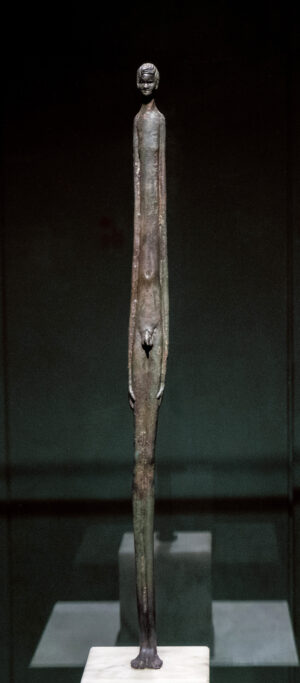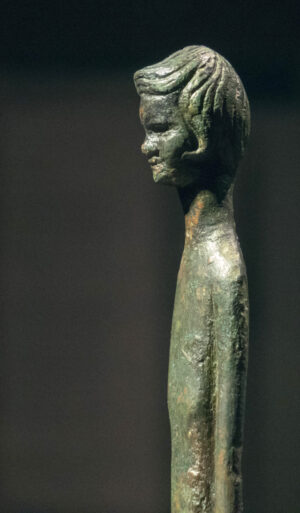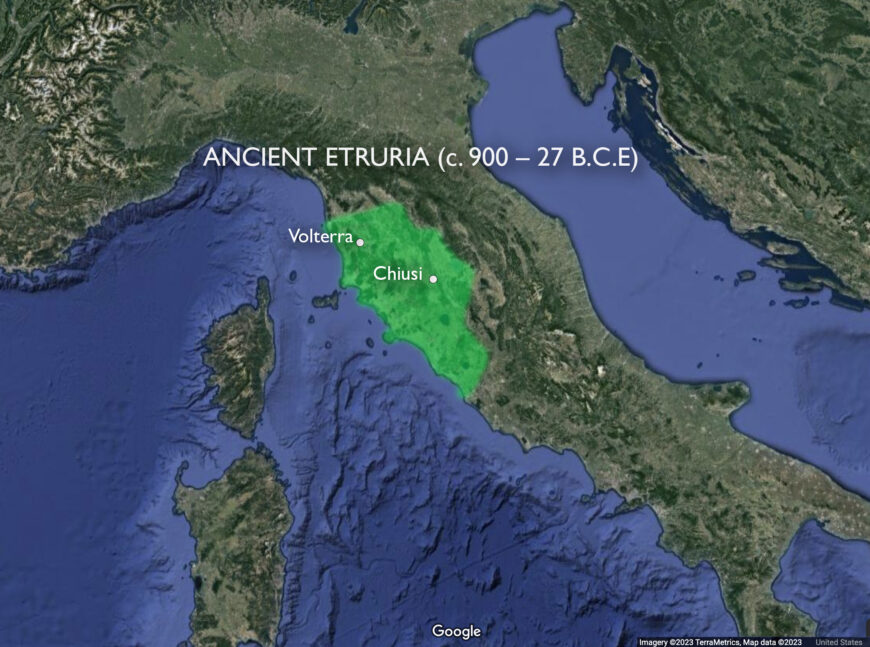
Ombra della sera (Evening Shade), 3rd century B.C.E., cast bronze, 57 cm high (Guarnacci Etruscan Museum, Volterra; photo: Egisto Sani, CC BY-NC-SA 2.0)

Alberto Giacometti, Walking Man II, 1960, bronze, 188.5 x 27.9 x 110.7 cm (National Gallery of Art, Washington, D.C.; photo: Steven Zucker, CC BY-NC-SA 2.0)
If this elongated, playfully distorted figure seems straight out of 20th-century art, it may be a surprise to learn that it is quite a bit older, dating all the way back to the Late Etruscan period in the 3rd century B.C.E. Long known as the Ombra della sera (Italian for “Evening Shade”), the figure does, indeed, cast a lengthy shadow, influencing famous 20th-century artists such as the Swiss sculptor Alberto Giacometti. Known for his disproportioned figurines, Giacometti stretched the human form in similar ways, creating his own “thin figures” that owed a profound debt to a somewhat enigmatic Etruscan tradition. The kinship, however, seems to end there. Giacometti’s rough-surfaced, peeling bodies evoke an almost existential, melancholy human experience while the Ombra della sera, and other figures like it, were votive objects, made expressly for dedication to the gods.
A votive object
Votive objects, sometimes called “ex-votos,” have a long history within Etruscan art and material culture going back to at least the 7th century B.C.E. Such gifts for the gods could include anything from costly large-scale bronze statuary (such as the Mars from Todi) to terracotta representations of body parts, to textiles, plants, or animals, all appropriate divine gifts in the right context.
Since its discovery sometime in the 1700s, the Ombra della sera has attracted much attention though it was not the only one of its kind. Others like it were found associated with a sanctuary dedicated to water divinities at the ancient Etruscan city of Volterra (Etruscan Veláthri). Located in the northwestern part of Etruria, the city was somewhat protected from incursions from Rome during the latter part of Etruscan history (the period during which these figurines were made).
Although they may date to the final phase of Etruscan material culture, the long, attenuated bodies may echo a much older tradition rather than some sort of new experimentation. Elongated bronze figures dating much earlier have been discovered from a handful of Etruscan sites such as Brolio (from the 6th century B.C.E.) and Chiusi (from the 5th and 4th centuries B.C.E.) with images of warriors, deities, and Etruscan priests (haruspices) as the most common subjects. Scholars hypothesize that these earlier examples may be a recollection of even more ancient forms originally made of wood or thin sheets of metal. Recently discovered evidence from the important Etruscan center of Campo Della Fiera at Orvieto suggests that these figures may have been set up on a base or block and arranged within a group to represent figures in the act of worship (think of the Eshnunna statuettes from ancient Mesopotamia.)

Profile (detail), Ombra della sera (Evening Shade), 3rd century B.C.E., cast bronze, 57 cm high (Etruscan Museum Guarnacci, Volterra; photo: Egisto Sani, CC BY-NC-SA 2.0)
A child
The Ombra della sera perhaps justly merits the singular attention it has received for a number of reasons. Etruscan art does not often depict children and, when it does, they are almost always clothed and not nude. This figure, clearly a young adolescent, features great detail in his head and facial features. His mouth is slightly upturned in the suggestion of a smile, he has the full cheeks of youth, and his hair falls in full, carefully outlined waves. The naturalism of the head (and, perhaps significantly, genitalia) does not extend to the torso or his limbs, all of which appear flat. The hyper elongation of the torso is echoed and emphasized by the arms which are held close by the body and the legs which are held tightly together making for a completely closed form. Through such formal aspects and deliberate distortion, the Ombra evokes the silhouette of a human figure projected on the ground at dusk or at dawn. The evocation or passage of time that seems to be implied may have been important in the rituals surrounding these figures (perhaps occurring at dawn or dusk). Alternatively, these figures may have been stretched or attenuated to grab the attention of the gods, a theory similar to one proposed for tiny objects found in votive contexts that miniaturize full-size examples of everyday things.
Whatever the intention behind the creation and ritual use of the Ombra della sera (and others like it from Volterra), the elongation of the human form marks a notable rejection of the ancient Greek classical style. Well-proportioned figures had long since become a standard part of Etruscan representational language, especially since the 5th and 4th centuries B.C.E., but during this last phase of Etruscan art and material culture, the deliberate distortion seen here suggests a profound if inscrutable need to connect with a much older past.
Additional resources
Gabriele Cateni, L’ombra della sera (Pisa: Felici Editore 2007).
Ingrid Edlund-Berry, “The Historical and Religious Context of Vows Fulfilled in Etruscan Temple Foundations,” Votives, Places and Rituals in Etruscan Religion: Studies in Honor of Jean MacIntosh Turfa, edited by Hilary Becker and Margarita Gleba (Leiden: Brill, 2008), pp. 101–06.
Sybille Haynes, Etruscan Civilization: a cultural history (Los Angeles: J. Paul Getty Museum, 2000).
Helen Nagy, “Votives in their Larger Religious Context,” A Companion to the Etruscans, edited by Sinclair Bell and Alexandra A. Carpino (Malden, MA: Wiley Blackwell, 2016), pp. 261–74.
Margherita Gilda Scarpellini, “The Bronze Votive Tradition in Etruria,” The Etruscan World, edited by Jean MacIntosh Turfa (New York: Routledge 2013), pp. 1026–40.
Jean MacIntosh Turfa, “Votive Offerings in Etruscan Religion,” The Religion of the Etruscans, edited by Nancy Thomson de Grummond and Erika Simon (Austin: University of Texas Press 2006), pp. 90–115.


